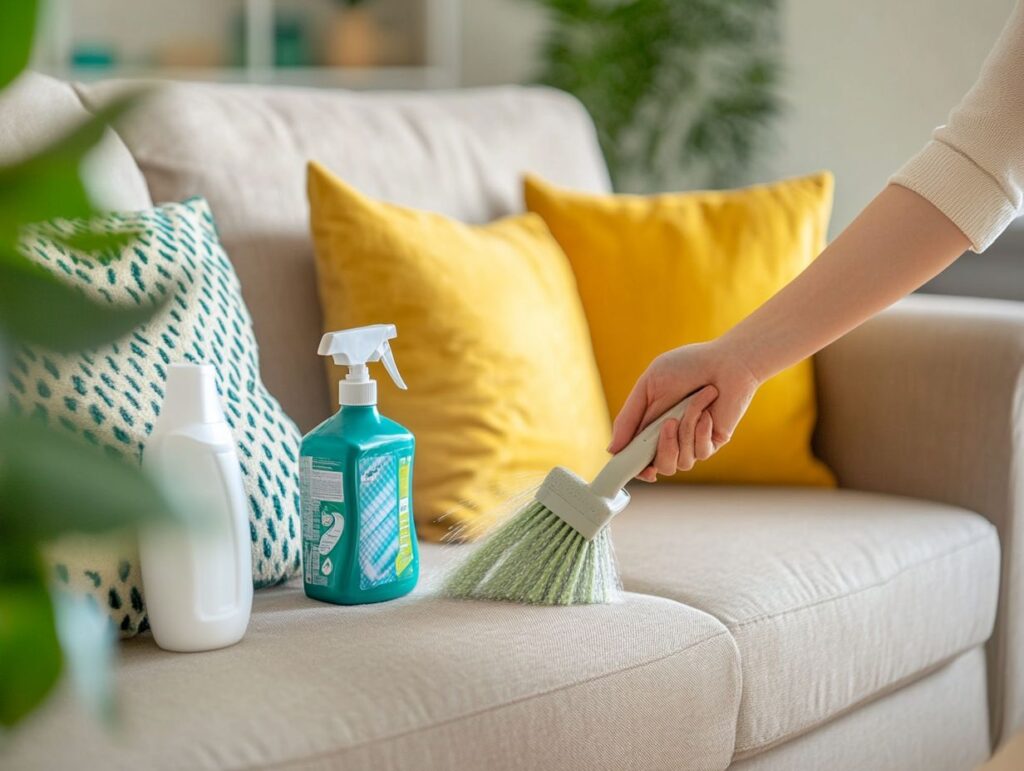Tips for Freshening Up Your Rental Property’s Upholstery Before Moving Out
Moving out of a rental property is often a daunting task, especially when you must leave everything in top-notch condition. One vital aspect tenants often overlook is the upholstery.
This article provides a comprehensive timeline and checklist for the move-out process, shares effective upholstery cleaning techniques, and offers tips on removing stubborn stains and odours. Additionally, we discuss ways to restore furniture’s appearance and maintain upholstery for the future. Get ready to ensure your space looks its best before handing over the keys!

Preparing for the Move-Out Process
Preparing for the move-out process is critical to making your transition from the rental property as smooth as possible and meeting the expectations in your tenancy agreement. If you take a systematic approach—such as creating a solid timeline and a detailed cleaning checklist—you can avoid potential disputes with your landlord and increase your chances of getting that security deposit back.
Furthermore, this assists you and prepares the property for the next tenant, making it more appealing in the rental market.
Timeline and Checklist
A timeline and checklist are your best friends when moving out. They’ll help you tackle all the necessary tasks and meet your responsibilities like a pro. Start by figuring out a cleaning schedule that matches your tenancy obligations. This will give you enough time for deep cleaning and a thorough property inspection for anything that could affect your security deposit. This proactive approach keeps you organised and protects your rights as a tenant by ensuring you leave the place in top-notch condition.
Effective time management is crucial for a smooth move, especially when scheduling cleaning tasks. Break your checklist into bite-sized segments, tackling the high-traffic areas first and gradually moving to those less-frequented spots. A thorough inspection of the property will help you spot any repairs needing attention, making that final walkthrough with your landlord much less stressful.
Keeping the property looking good can also make a difference. Make sure to take care of any minor repairs and declutter the space to create a positive impression. By incorporating these strategies, you’ll be in a much better position to secure the full return of your security deposit.
Cleaning and Freshening Up Upholstery
Cleaning and freshening up upholstery is crucial for preparing your rental space for the next tenant, and it also helps improve your living environment while you’re moving out.
Upholstery tends to collect dust, allergens, and unpleasant odours, so it’s vital to use effective cleaning methods that suit the specific fabric types in your home.
By opting for eco-friendly cleaners, steam cleaning, or even hiring professional services if necessary, you can ensure your furniture looks fantastic and meets the cleanliness standards that landlords and future tenants expect.
Step-by-Step Guide
A step-by-step guide to cleaning upholstery can make the whole task less intimidating and more effective. First, figure out what type of upholstery fabric you’re dealing with. Different materials have cleaning quirks, and you don’t want to damage anything accidentally. For example, microfiber usually needs some simple spot cleaning, while leather might benefit from a more specialised approach, like using protective sprays or calling in professionals.
Once you’ve identified the fabric, it’s time to gather your supplies: a vacuum cleaner, soft brushes, and some DIY cleaning solutions made from natural ingredients like vinegar, bicarbonate of soda, or Castile soap. Start by vacuuming thoroughly to remove all that dust and debris. Then, do a patch test with your cleaning solution in a hidden spot to ensure no discolouration.
A mixture of vinegar and water can work wonders for those pesky stubborn stains. After you’ve cleaned everything up, make sure to let the upholstery air dry properly to keep mould and mildew at bay. And don’t forget about regular maintenance! Using fabric protectors can help guard against spills and keep your furniture looking fresh for longer.
Removing Stains and Odours
Removing stains and odours from your upholstery is essential to creating a fresh and inviting space, especially when moving out. We all know that stains, especially pet stains, can be a real headache.
That’s why using the right cleaning products and techniques can be a game changer. Whether you choose the DIY route or hire professionals, knowing effective stain removal methods will help you restore your upholstery to its prime while enhancing its durability and appearance.
Effective Techniques and Products
Effective techniques and the right products are key to a successful cleaning experience when tackling stains and odours.
Mixing and matching different methods and products can elevate your cleaning game. For example, using a combination of vinegar and water as a surface cleaner removes grime and acts as a natural deodoriser.
Regarding fabric sanitisers, be sure to pick those that specifically target odour-causing bacteria for that long-lasting freshness you’re after. And here’s a handy hack: treat any spills immediately with a blotting technique. This helps absorb the liquid before it gets a chance to settle in.
Adding bicarbonate of soda to your routine can work wonders, too. It helps neutralise odours and can be a gentle abrasive for tougher stains. Keeping a spotless and pleasant environment becomes easier and more enjoyable with these tips in your cleaning arsenal.
Restoring the Appearance of Furniture
Restoring the appearance of your furniture is a key part of getting ready to move out. It’s not just about making things look nice; it also helps maintain the overall value of your rental investment.
Whether you decide to reupholster or do some simple upholstery repairs, giving your furniture a fresh look can make a difference.
This is especially important if you’re staging your home for potential buyers or future tenants. Well-maintained furniture leaves a great first impression and enhances your home’s value.
DIY Techniques and Professional Services
When you want to restore your furniture, combining DIY techniques with professional services can give you a well-rounded approach to achieving the best results.
For example, simple tasks like refinishing surfaces or fixing minor scratches are completely doable with products you can pick up at your local hardware shop. Many homeowners find refreshing a beloved piece of furniture very satisfying.
But for more intricate jobs, like reupholstering chairs or restoring valuable antiques, it’s time to call the professionals. Their expertise and specialised tools can help you avoid potential damage and ensure the final result meets high-quality standards.
By weighing the pros and cons of each method, you’ll make a more informed decision about how to breathe new life into your cherished furniture.
Tips for Maintaining Upholstery in the Future
Maintaining your upholstery is key to prolonging its life and keeping it looking great in your living space. You can work out a cleaning routine that suits your lifestyle by learning about the different types of upholstery fabrics and their specific maintenance needs.
Furthermore, using some fabric protection techniques and maintaining regular furniture upkeep will help you avoid wear and tear, ensuring your upholstery remains durable and visually appealing.
Preventive Measures and Regular Cleaning
Implementing some preventive measures and adhering to a regular cleaning schedule can enhance your upholstery’s lifespan. Using the right upholstery tools and eco-friendly cleaners will minimise the buildup of dirt mites and allergens, creating a healthier space. Finding a consistent cleaning frequency that fits your lifestyle will help keep your upholstery looking fresh and inviting, plus it’ll save you from those costly repairs later on.
Regular vacuuming with a high-efficiency particulate air (HEPA) filter can remove dirt and debris that often cling to fabric fibres. Soft brushes and lint rollers are your best friends for dislodging stubborn particles that your vacuum might miss.
Incorporating eco-friendly cleaning solutions protects your upholstery’s fibres and creates a safe indoor atmosphere free from harsh chemicals.
By opting for natural alternatives like vinegar or bicarbonate of soda, you’re taking care of your upholstery and contributing to a sustainable living approach. It makes upholstery care efficient and environmentally friendly!
